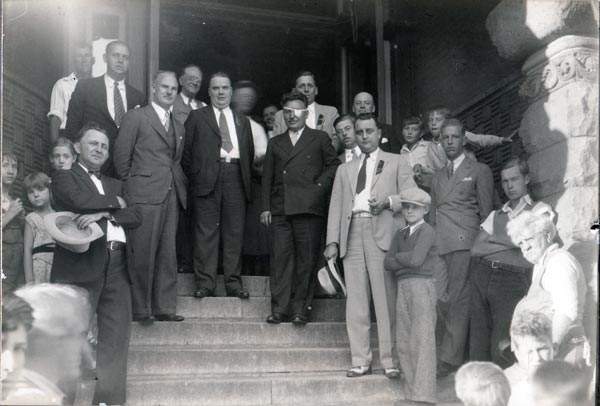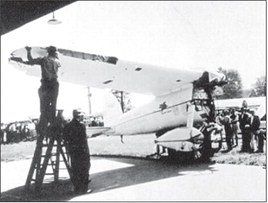Story of Quincy's Monroe Airport, Wiley Post

In the early days of
aviation, few communities had paved runways for planes to land. Most just had
graded landing strips in fields. But aviation and the miracle of flying could
not be stopped. As early as 1912, an Air and Land Speed Carnival was held at
Baldwin Park (30th and Maine) on June 8-9. Two planes arrived by train. Besides
aerial maneuvers, there were races between plane and auto and plane and
motorcycle. Four thousand people came to see the contests and to view the
planes up close.
As barnstormers made their way across the country, they made
money for gasoline by charging for rides. In 1919, it cost $10 for 10 minutes
for a ride over Quincy. At this time, the two best places for landing in Quincy
were the north end grounds of the Quincy Country Club near 26th and State and
the infield at Baldwin Park. The first airport in the area was Taylor Field in
West Quincy in 1930. However, other people wanted a closer operation.
Neal Monroe became the first Quincyan active in aviation. He
established a temporary landing field in 1927 at what is today Cedar Crest
Country Club. Later Monroe purchased land near 36th and Payson Road for a
landing strip. Two planes were housed in the wooden hangar there in 1928 when
fire destroyed the building. One of the planes was saved, and another hangar
was built. Later, through the Civil Works Association, forerunner of the Works
Progress Administration of the Depression era, a brick hangar was built large
enough for ten planes and office space.
This building is at 36th and Payson
Road and is currently used as a warehouse for Niemann Foods.

Monroe left Quincy in 1930, and the city of Quincy took over operation of the airfield. Gov. Henry Horner and other dignitaries came to Quincy to dedicate the airport on Nov. 25, 1934. Named Monroe Airport, it would serve the city until June 1, 1947, when the new Municipal Airport (later named Baldwin Field) became the official Quincy airport.
Monroe Airport had a number of famous visitors. On April 15, 1929, a tri-motor, all-metal 14-passenger plane built by the Ford Motor Company landed at the field. This type of plane was designed by William B. Stout, a native of Quincy, who also designed the first commercial monoplane in 1919, the first all metal plane and the first torpedo plane. Stout sold his company in 1924 to Henry and Edsel Ford.
The May 19, 1932, edition of The Quincy Herald-Whig relates that “Maj. Jimmy Doolittle, speed king of the skies, holder of the trans-continental flight record and famous army aviator, paid the Quincy airport a brief visit Thursday afternoon. The doughty little major is a pilot for the Shell Petroleum Corporation having retired from the army two years ago.” Major Doolittle broke many speed records in aviation, but he is best known for leading the Doolittle Raiders during World War II, bombing Tokyo in April 1942.
On August 15, 1938, a pilot by the name of Collins flew from Peoria to Quincy and wrote in the Monroe Airport logbook, “Came after Mary Pickford and Buddy Rogers.” Pickford was one of the era’s great silent screen actresses, and her husband, Charles “Buddy” Rogers, was a famous actor and band leader of the day.
The Historical Society of Quincy and Adams County has
the Monroe Airport flight logbook among its possessions. Inside the cover it
lists the airport as being at latitude: 39 degrees, 54 minutes; longitude: 91
degrees, 22 minutes, and the field altitude as being 663.16 feet above sea
level.
The most significant event at Monroe Airport occurred on
September 21, 1933, with the crash of the “Winnie Mae.” The pilot and
owner of the Winnie Mae was none other than
Wiley Post, perhaps the most famous aviator of his day. In 1931 he and a friend
had broken the record for flying around the world with a time of 8 days, 15
hours and 51 minutes. In 1933 he broke this record in a solo flight of 7 days,
18 hours and 49 ½ minutes flying the beautiful blue and white “Winnie Mae”
Lockheed Vega single engine aircraft on both trips. This is the plane that
brought Wiley Post to Quincy on September 20, 1933.
Post was making a goodwill tour of the country for the Socony-Vacuum Corporation. He was met at the airport by Mayor Leo W. Lenane and a welcoming committee and was given the key to the city. Post was hosted at a dinner at the Lincoln-Douglas Hotel where he urged Quincy to get on the aviation maps as a port of call for planes traveling regular routes cross country.
The next day, as Wiley Post left Monroe Airport, the Winnie Mae had reached a height of about 50 feet, when the engine cut out. The plane came down, hitting a tree at the west end of the runway. Post was able to climb out of the plane, which was badly damaged. He had an inverted “V” shaped cut stretching from his hairline to the outside edge of both eyes. He was rushed to St. Mary’s Hospital and was attended by Dr. E. L. Caddick. Post had a skull fracture, and his right arm, previously injured in a car accident, had again been stressed, but not broken.
Mrs. Post came to Quincy to be with her husband. Both of them returned to their home in Oklahoma City on Sept. 29, 1933, in the private plane of Quincyan L. P. Bonfoey. The Winnie Mae was shipped by truck to Oklahoma City by the King Transfer Company. The Winnie Mae was repaired and today is in the Smithsonian Institution. Less than two years after the accident in Quincy on Aug. 16, 1935, Wiley Post and Will Rogers died in a plane crash in Alaska.
With newer aviation technology came the need for a larger airport and thus the end of Monroe Airport. The old hangar at 36th and Payson Road is our reminder of aviation in Quincy long ago.
Patrick McGinley is retired from Quincy Public Schools and later John Wood Community College. He earned his doctorate from Southern Illinois University at Carbondale and is secretary of the Board of the Historical Society of Quincy and Adams County.
Sources
"Monroe Airport Flight Log." Historical Society of Quincy and Adams County.
Quincy Herald-Whig, May 19, 1932.
Quincy Herald-Whig, September 21, 1933.
Quincy Herald-Whig, August 8, 1941.
Quincy Herald-Whig, April 11, 1976.
Quincy Herald-Whig, April 25, 1976.
Quincy Herald-Whig, September 22, 1976.
Quincy Herald-Whig, December 28, 1997.
Quincy Herald-Whig, July 19, 1981.
Quincy Herald-Whig, October 24, 1982.
Quincy Herald-Whig, April 24, 1994.
Quincy Herald-Whig, April 30, 2000.






